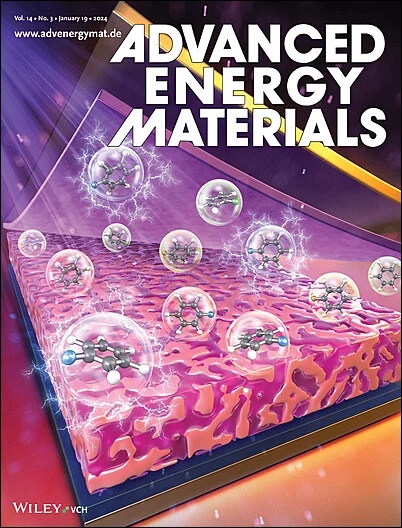From Operando Investigations to Implementation of Ni‐MOF‐74 Oxygen Evolution Electrocatalysts
IF 26
1区 材料科学
Q1 CHEMISTRY, PHYSICAL
引用次数: 0
Abstract
Metal‐organic frameworks (MOFs) as electrocatalysts for the alkaline oxygen evolution reaction (OER) show promising catalytic activity by offering great variability and high surface areas, enabling performance optimization and mechanistic studies. However, their stability during reaction and the structure‐performance relationship defining the origin of the high OER activity, are still vigorously debated. Herein, operando X‐ray absorption spectroscopy and operando X‐ray diffraction are applied to unveil the structural and electronic transformations of Ni‐MOF‐74 during OER. The irreversible destruction of the MOF‐74 crystal into a highly OER active, amorphous NiOOH‐metal organic compound is identified. Based on these findings, an amorphous Ni metal organic compound (Ni‐MOC*) is proposed for achieving high current densities both in a three‐electrode cell (14 A g从Operando研究到Ni - MOF - 74析氧电催化剂的实现
金属有机骨架(MOFs)作为碱性析氧反应(OER)的电催化剂,具有较大的可变性和高的比表面积,具有良好的催化活性,可以进行性能优化和机理研究。然而,它们在反应中的稳定性和结构-性能关系定义了高OER活性的起源,仍然存在激烈的争论。本文利用X射线吸收光谱和X射线衍射技术揭示了Ni - MOF - 74在OER过程中的结构和电子转变。MOF - 74晶体的不可逆破坏被鉴定为高度OER活性的无定形NiOOH -金属有机化合物。基于这些发现,提出了一种非晶镍金属有机化合物(Ni‐MOC*),用于在三电极电池(在1.5 VRHE下14 a gNi−1)和阴离子交换膜水电解槽(AEM‐WE)中实现高电流密度,在500 mA cm−2下AEM‐WE性能稳定超过100小时。
本文章由计算机程序翻译,如有差异,请以英文原文为准。
求助全文
约1分钟内获得全文
求助全文
来源期刊

Advanced Energy Materials
CHEMISTRY, PHYSICAL-ENERGY & FUELS
CiteScore
41.90
自引率
4.00%
发文量
889
审稿时长
1.4 months
期刊介绍:
Established in 2011, Advanced Energy Materials is an international, interdisciplinary, English-language journal that focuses on materials used in energy harvesting, conversion, and storage. It is regarded as a top-quality journal alongside Advanced Materials, Advanced Functional Materials, and Small.
With a 2022 Impact Factor of 27.8, Advanced Energy Materials is considered a prime source for the best energy-related research. The journal covers a wide range of topics in energy-related research, including organic and inorganic photovoltaics, batteries and supercapacitors, fuel cells, hydrogen generation and storage, thermoelectrics, water splitting and photocatalysis, solar fuels and thermosolar power, magnetocalorics, and piezoelectronics.
The readership of Advanced Energy Materials includes materials scientists, chemists, physicists, and engineers in both academia and industry. The journal is indexed in various databases and collections, such as Advanced Technologies & Aerospace Database, FIZ Karlsruhe, INSPEC (IET), Science Citation Index Expanded, Technology Collection, and Web of Science, among others.
 求助内容:
求助内容: 应助结果提醒方式:
应助结果提醒方式:


